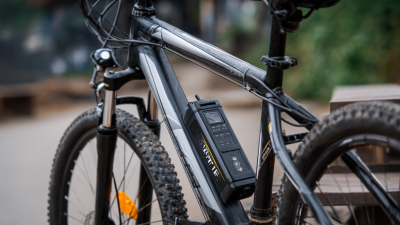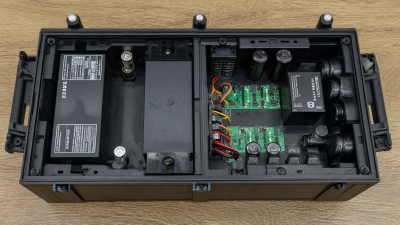In recent years, the demand for electric bikes has surged, positioned as a sustainable alternative to traditional transportation methods. A critical component facilitating this shift is the Bicycle Lithium Battery, which has proven to be a game-changer in the industry. According to a report by the Global Bicycle Market Research, the e-bike segment is expected to grow at a CAGR of 7.5% through 2026, underscoring the importance of high-performance batteries in enhancing range and efficiency. Lithium batteries, known for their lightweight and high energy density, play an integral role in maximizing performance while contributing to environmental sustainability. As enthusiasts and commuters alike seek reliable options, understanding the nuances of bicycle lithium batteries becomes vital.

This guide aims to provide insights into selecting the ideal battery that meets individual cycling needs, ensuring that whether you are a casual rider or an adrenaline seeker, your biking experience is enhanced to its fullest potential.
When it comes to selecting the right lithium battery for your bicycle, understanding the various types available is essential. The two main categories are lithium-ion (Li-ion) and lithium iron phosphate (LiFePO4). Li-ion batteries are well-known for their high energy density, which translates to a longer range for your rides. They are typically lighter and more compact, making them an excellent choice for performance-oriented cyclists. However, they may have a shorter lifespan compared to other types, which can impact long-term use.
On the other hand, lithium iron phosphate batteries are prized for their safety and stability. They can endure more charge cycles than Li-ion batteries, making them a cost-effective option for those who ride frequently. Although they are generally heavier and bulkier, their robustness and lower risk of overheating or catching fire can provide added peace of mind for riders concerned about safety. Understanding these differences will help you choose the battery that best meets your biking needs and enhances your overall riding experience.
When selecting a lithium battery for your bicycle, understanding the cycle life and performance of various options is crucial. Cycle life refers to the number of complete charge and discharge cycles a battery can undergo before its capacity falls below 80% of its original value. According to a study published in the Journal of Power Sources, lithium iron phosphate (LiFePO4) batteries typically boast a cycle life of around 2,000 to 3,000 cycles, significantly outperforming traditional lithium-ion batteries, which often offer only 500 to 1,000 cycles. This extended lifespan translates to lower long-term costs and less frequent replacements, making LiFePO4 an appealing choice for avid cyclists.
In addition to cycle life, performance metrics such as energy density and discharge rate are paramount. Energy density, measured in watt-hours per kilogram (Wh/kg), indicates how much energy a battery can store relative to its weight. Recent industry reports indicate that lithium nickel manganese cobalt oxide (NMC) batteries can achieve energy densities as high as 250 Wh/kg. This means that for high-performance electric bicycles, an NMC battery not only extends range but also enhances the bike's overall efficiency. Furthermore, the discharge rate, which affects how quickly energy can be delivered during high-demand conditions, is critical for performance on inclines or during acceleration. Understanding these factors is key to optimizing your ride and ensuring you select the right battery for your cycling needs.

When selecting a lithium battery for your bicycle, several key factors come into play that can significantly influence your riding experience. One primary consideration is the battery's capacity, measured in amp-hours (Ah). According to the US Department of Energy, a higher capacity typically means a longer range, with many e-bikes requiring batteries between 300Wh to 700Wh to achieve optimal performance for commuting or long-distance rides. Another crucial factor is the discharge rate; higher discharge rates (often specified in C ratings) allow for quicker bursts of power, which is essential for steep ascents and acceleration.
Tips: When choosing a battery, always check compatibility with your bike's motor system, as mismatched specifications can lead to underperformance or even damage. Furthermore, take into account the battery's weight; while lithium batteries are lighter than traditional lead-acid ones, opting for a lighter option can enhance your overall ride quality.
Temperature stability is also a significant factor; lithium batteries perform best between 32°F and 113°F. Exposure to extreme temperatures can affect battery efficiency and lifespan, with studies indicating that a well-maintained battery can last up to 1,500 charge cycles. Understanding these aspects can guide you in making an informed decision, ensuring that your bicycle's performance meets your needs.
When choosing lithium batteries for bicycles, safety is paramount. Lithium-ion batteries, the most commonly used type, generally offer a high energy density and longer life cycle; however, they are also susceptible to risks such as thermal runaway, which can lead to fires if not handled correctly. According to a report by the National Fire Protection Association, lithium battery incidents have led to over 2,000 fires annually in recent years, emphasizing the need for proper safety measures.

Another important consideration is the type of lithium battery chemistry. Lithium iron phosphate (LiFePO4) batteries, while heavier and offering lower energy density, present a lower risk of overheating and combustion. A study by the Department of Energy's Argonne National Laboratory found that these batteries had significantly improved thermal stability compared to traditional lithium-ion cells. Additionally, various manufacturers are now implementing advanced Battery Management Systems (BMS) that monitor temperature and charge to enhance safety and prolong battery life.
When selecting a battery for your electric bicycle, it’s crucial to consider not just the performance specifications but also the safety features, such as built-in protection circuits and certifications from recognized standards organizations. The right choice can mitigate risks and provide a safer riding experience, ensuring that your journeys are not only thrilling but also secure.
The future of lithium battery technology is poised to significantly enhance cycling experiences. With advancements in energy density, newer lithium batteries are expected to provide longer ranges and lighter weights, which is crucial for both casual riders and serious cyclists. Emerging technologies such as solid-state batteries promise to eliminate some of the safety risks associated with traditional lithium-ion batteries while also extending their lifespan. This innovation not only enhances performance but also boosts the overall efficiency of electric bicycles.
Another trend shaping the future of cycling batteries is the integration of smart technology. Manufacturers are increasingly developing batteries that can communicate with other electronic systems on the bike, including performance apps that help monitor battery health, cycling performance, and charging statuses. Furthermore, recycling initiatives and sustainable sourcing of lithium materials are becoming central to battery production, addressing environmental concerns that come with increased battery usage in the cycling community. These advancements will undoubtedly transform how cyclists approach battery selection, optimizing both performance and environmental impact.
This chart provides a comparison of different types of lithium batteries used in cycling applications, showcasing their weight and capacity. As the demand for lightweight and high-capacity batteries grows in the cycling industry, understanding these metrics is crucial for making informed choices.








